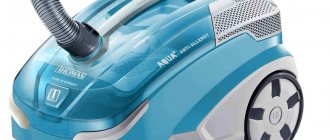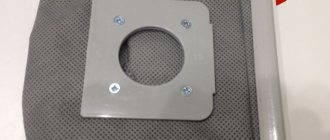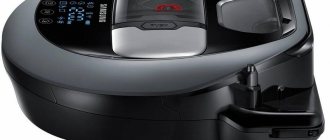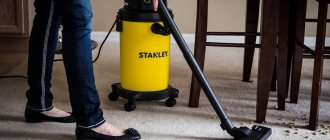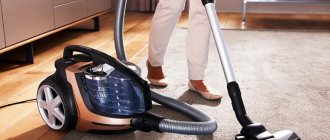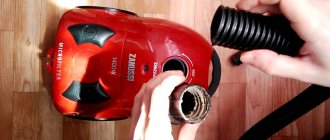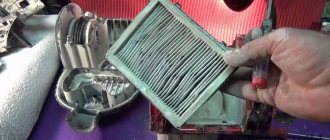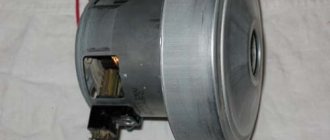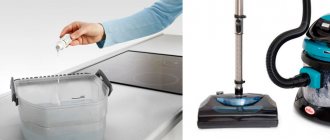Cleanliness in the house is an important condition for maintaining housing.
Dust settling on carpets, laminate, and parquet is a habitat for pathogenic microorganisms and is dangerous to human health.
You can effectively remove dirt from the floor using a vacuum cleaner . However, by regularly coming into contact with particles of debris, this device itself quickly becomes dirty and requires cleaning.
Causes of pollution
The most susceptible to clogging are the working brush attachments, the telescopic handle and the suction hose of the device. The main reason for the formation of dust accumulations on these elements is cleaning surfaces with a high degree of contamination - food debris, candy wrappers.
To avoid deterioration in the quality of the vacuum cleaner or its failure, before using it, first sweep all large debris from the floor with a broom.
The main reasons for contamination of the device:
- insufficient care of the device (irregular emptying of the dust container);
- loose connection of filters to the housing;
- use of damaged dust collectors - if the integrity of the bag or container is damaged, particles of debris penetrate into the “heart” of the device - the electric motor, which can lead to its breakdown.
IMPORTANT! If it is necessary to clean the room after renovation work, first sweep up construction debris and then remove any remaining small dirt with a vacuum cleaner.
How often to clean?
How often you clean your device depends on several factors.:
- area of the premises, number of people living, presence of pets;
- intensity of use of the device and type of vacuum cleaner.
When processing large areas, shake out the contents of the container or garbage bag after each use of the vacuum cleaner.
If the house is small, emptying the dust container every 3 cleanings will be sufficient.
In a room where several people live or where there are pets, the vacuum cleaner usually has to be used daily. Therefore , at least once every six months, carry out a complete cleaning procedure for the device.
Also, the number of cleaning procedures for a vacuum cleaner depends on its design features: if the device is equipped with an aquafilter, wash the dust collection container after each cleaning. Shake out reusable bag devices when they are 2/3 full of trash.
The need to clean the vacuum cleaner is indicated by spontaneous shutdown of the device during operation.
The device stops due to overheating of parts and components, which can be caused by the following reasons:
- clogging of the inlet or flexible hose;
- accumulation of contaminants on the filter elements;
- clogging of the motor.
A sign indicating the need to wash the vacuum cleaner is a deterioration in its suction properties.
How to properly clean a turbo brush for a vacuum cleaner from hair and fur?
Our housekeeping expert
Hello, Polina! First, let's look at how the device works. There are mechanical and electrically driven brushes. The former work due to the force of the sucked air: the higher the power of the vacuum cleaner, the better the device can clean the surface. Electrically driven brushes are much more expensive, but they do not depend on power, since the roller rotates autonomously. True, such a miracle of technology can “overdo it” and pull fibers out of the carpet along with the dust. The choice is yours.
Most often, simple mechanical brushes are used, which are included with the vacuum cleaner.
If you don't already have such a device, be sure to buy one at your local hardware store.
Such a nozzle is inexpensive, but the benefits are simply enormous. And for it to work properly, all parts must sometimes be cleaned of debris.
Regular care
You should not clean the turbo brush after each use of the vacuum cleaner. But there is no need to delay this either. After you have vacuumed the apartment 3-4 times, it’s time to free the roller from the tangled hair. For this:
- Remove the turbo brush from the vacuum cleaner pipe.
- Lightly press the handle until the latch moves slightly.
- Remove the protective cover.
- Wipe the surface with a dry cloth to remove dust and debris.
- Using tweezers and scissors, free the roller from fur and hair.
- Remove the cover in the area of the blades and remove all dirt from there.
- Close the lid.
This is quite enough for the roller to work properly again. However, after a while, such cleaning no longer helps, so you have to disassemble the nozzle and clean it from the inside.
How to disassemble and clean the turbo brush
It is advisable to clean this vacuum cleaner attachment more thoroughly once every six months. To do this you need to disassemble it:
- Remove the protective cover.
- Turn the nozzle over. On the inside you will see 6 screws. Unscrew them using a screwdriver.
- Carefully separate the brush into two halves.
- Wipe the inside surface with a clean cloth. Hard-to-reach places can be cleaned with a vacuum cleaner pipe.
- Remove hair, fur and dirt from all parts of the mechanism. To do this, you can use the same tweezers and scissors.
- Collect the brush.
That's the whole cleaning process. In principle, this is not difficult to do even without outside help. If there are pets in the house, then the nozzle will have to be disassembled every 3 months, then it will be able to work with maximum power.
Preparatory stage
Before starting to disassemble the device, put on an apron and rubber gloves.
To prevent dust from getting onto the floor when disassembling the vacuum cleaner, use a small piece of polyethylene (100x100 cm) or oilcloth as a bedding.
To clean the device directly, prepare detergent, a stiff sponge, and a microfiber cloth.
What do you need for work?
Proceed to disassemble the device (according to its instructions):
- disconnect the device from the power supply, wait until the case cools down after work;
- place the vacuum cleaner on the spread polyethylene;
- wipe the cord with a slightly damp cloth and wind it up;
- open the case, remove the dust container;
- Clean the outer and inner surfaces of the vacuum cleaner body with a damp cloth and wipe the lid.
Pay special attention to the holder (the bag fastening part) - if debris remains on it, the hose will enter the hole with an offset and dust will penetrate inside the vacuum cleaner during the cleaning process.
Subtleties of repair
If your cord is not winding well or the winder reel is not working, inspect the reel itself and its mechanical trigger. Inspect the device for debris, which often causes poor wire winding. Use scissors or thin pliers to remove it.
If your vacuum cleaner turns off after not working for even a few minutes, the problem lies in the motor overheating. Here you need to inspect the dust collector itself, clean it if necessary, and also check all the inlets and outlets of the filters. If you wash filters, make sure there is no moisture on them. Moisture can cause equipment to shut down.
If you cannot adjust the power of the vacuum cleaner, check the circuit and inspect for mechanical damage. Often the cause of this malfunction is the destruction of the power control knob itself.
One of the most common breakdowns is engine contamination. If this happens, you will hear extraneous noise inside the equipment or a strong whistle. It is necessary to disassemble the vacuum cleaner, remove the engine and inspect it. If you see dust on it, this is the reason for the strange noise inside the equipment. Clean the motor; for this you will need a regular brush.
We invite you to familiarize yourself with Odor absorber folk remedies
After the repair, you need to reassemble the vacuum cleaner in reverse order. First, attach the motor and dust collector, be sure to screw the parts tightly. Connect each terminal, install the power switch board, secure it with a bolt if there is one. Once all the parts are in place, close the housing.
How difficult and expensive the repair will be depends on the cause of the problem. Typically, repairs of Electrolux vacuum cleaners are divided into three types:
- Simple repair (in principle, it is as easy as repairing Bosch vacuum cleaners);
- Medium renovation;
- Difficult repair.
The first type of repair includes the following work:
- replacement of cracked elements of the Electrolux vacuum cleaner body;
- restoring the integrity of the cord winding;
- replacing worn-out attachments (this is especially difficult to do with LG robotic vacuum cleaners).
- eliminating blockages in the water supply system (only a washing-type vacuum cleaner has such a defect).
In case of these breakdowns, repairs are carried out quickly; if you have to change spare parts and attachments, the price for them is low, so such work will cost from 200 to 1000 rubles. Any store sells a wide variety of nozzles, so you can buy the nozzles yourself.
For these more complex faults, you have to replace expensive Electrolux vacuum cleaner parts, so the repair takes much longer. For this repair you will have to pay from 1000 to 2000 rubles.
Complex repair of an Electrolux vacuum cleaner includes eliminating the consequences of engine overheating or wear. Usually you have to change the engine or expensive spare parts.
Replacing them will cost approximately 2000-2500 rubles if you repair a simple vacuum cleaner and 3000-3500 rubles if you repair a washing vacuum cleaner. But diagnostics and repairs of Karcher vacuum cleaners are much more expensive, so this is not such a problem.
Vacuum cleaner care
In order for the Electrolux vacuum cleaner to work well and not require repairs, manufacturers recommend following the following rules:
- Do not use a household vacuum cleaner to clean large industrial areas; this will cause the engine to overheat and the brushes, filters and hoses to wear out faster.
- Do not exceed the continuous operation time specified in the instructions.
- Clean the vacuum cleaner bag in a timely manner.
- Do not kink the hose.
- Clean the filter regularly as it helps keep moving parts of the engine free from dust.
- Do not wash the filter so as not to reduce its capacity. A faulty filter causes the engine to overheat.
- Do not repair the vacuum cleaner, change its spare parts yourself.
- Store the vacuum cleaner in a dry place.
- It is better to store all brushes and attachments in the case, in a specially designated place for them.
- Old stubborn dirt should be cleaned with a special turbo brush, since a regular brush will not help.
If they are followed, the Electrolux vacuum cleaner will work flawlessly for several decades.
How to wash different types of appliances?
There are the following types of vacuum cleaner filters:
- bag;
- aqua filters;
- cyclonic.
Most modern models of vacuum cleaners are equipped with a hepa filter - a fine cleaning device.
Bag filter
The product is made of paper or synthetic, dense fabric.
Paper bags are used once, after which the filters must be replaced.
You can use woven products for a long time.
Cleaning Reusable Bags:
- remove the filter from the holder;
- remove all contents of the dust container;
- rinse the bag under running water;
- you can also put it in a basin filled with liquid: after a while, dust and debris will settle to the bottom, after which remove the filter and rinse under the tap;
- Dry the product and place it in a vacuum cleaner.
With aqua filter
This type of dust collector is a plastic container filled with water. The dust sucked up by the vacuum cleaner falls into the container, where the dirt particles are saturated with moisture and sink to the bottom.
The container is intended for repeated use; rinse it under running water after each cleaning using detergents that do not corrode plastic.
Before installing the filter in the vacuum cleaner, dry it.
IMPORTANT! To avoid deformation of the container, use only cold water when washing.
With cyclone filter
The receiver device consists of a plastic container and several filters.
Garbage is collected into the main container by generating an air vortex by the vacuum cleaner: dry particles of dirt, moving in a spiral, settle on the walls of the intermediate container, after which they fall into the receiver.
After cleaning, remove the device, disassemble it and clean each filter, and rinse the container with water and dry.
With hepa filter
The Hepa filter is designed to clean the air flow coming out of the vacuum cleaner from the smallest particles of dust and animal hair.
Depending on the materials used in the production process, filters can be disposable (made of cellulose) or reusable (made of fluoroplastic fibers).
The first type of product must be replaced after cleaning, the second type requires long-term operation and periodic cleaning:
- Water method . Remove the product from the vacuum cleaner and rinse it under strong pressure with clean, cold water without brushes or rags, dry it and put it back in its original place. Detergents should not be used, as their use can lead to a deterioration in the filter’s throughput.
- Air method - blowing the device with a powerful air flow directed in the direction opposite to the direction of filtration.
Some owners of vacuum cleaners with a paper dust collector also blow out the filter with compressed air. This procedure can restore the dust collector’s collecting capacity if carried out 1-2 times. With further attempts to treat with air, there will be no restorative effect.
An eternal vacuum cleaner, or rules for caring for household appliances
Of course, technology does not last forever, but every person has the power to extend its service life. One of the most useful and at the same time the most common device to fail is a vacuum cleaner. And the reason for breakdowns, as a rule, is one - improper operation of the device. Therefore, below we will talk about how to clean the vacuum cleaner after cleaning and thereby avoid its rapid breakdown.
Before looking at cleaning methods for a vacuum cleaner, you need to know a little about the different types that exist. All vacuum cleaners can be divided into the following types - regular bagged, container (bagless), with an aqua filter, washing and mops. Standing apart are robotic vacuum cleaners, which are not entirely related to the topic, but they also have something to clean.
Depending on the type of vacuum cleaner, the methods for washing it may vary, but in general the scheme is the same.
The most important element in the device, which directly affects its operation and service life, is the filter. No matter what kind of vacuum cleaner, it will definitely have a filter. As a rule, there are even two of them. The first one stands at the entrance to the motor and protects it from dirty air; in fact, it is called the motor one. The second filter is located at the outlet of the vacuum cleaner and its task is to stop microparticles that could still escape the container or bag, as well as the motor filter.
Proper care of a regular vacuum cleaner
After each cleaning of the apartment, it is necessary to take care of the main assistant in this matter and clean him himself. For a bag and container vacuum cleaner, the scheme is approximately the same:
- The bag or container must be cleared of debris and the container must be wiped if necessary. You should not wash it, otherwise you will have to wait a long time until it dries completely.
- A disposable bag must be disposed of immediately, while a reusable bag should be washed or at least shaken out periodically. It is worth remembering that it is made of air-conducting material and catches dust, but when it is full or if it is not washed or changed for a long time, it will no longer allow air to pass through, which will affect the suction power and, accordingly, the quality of cleaning.
- The next cleaning step is to wash the filters. The first is the motor filter, which protects the motor from clogging. It is essentially a sponge, so it can be washed. Of course, it all depends on how often you use the vacuum cleaner, but as it becomes clogged, you need to thoroughly clean the filter. Otherwise, dust will begin to clog in the motor, it will begin to heat up, which will inevitably lead to the fact that the motor will simply burn out, and such a breakdown cannot be repaired. Depending on use, but at least once every six months, the filter should be completely changed.
- After this you can move on to the output filter. In most modern vacuum cleaners it is called a fine filter, and it is called HEPA. There are several types - HEPA 11, 12, 13 and 14. The last two can be washed, the previous two cannot be wetted. It can be cleaned with a brush, some people blow it with a hair dryer on cold. After washing, the filter should be placed in a dark place and allowed to dry on its own. The sun, hot radiator and other drying methods are strictly contraindicated. Such filters should also be changed periodically, but due to the fact that the intensity of their use is much lower, this can be done no more than once a year.
The fine filter is responsible for the cleanliness of the air leaving the device, and if it is clogged, the air will be the same, which means that the whole point of cleaning is lost.
Washing vacuum cleaners and models with an aqua filter
The general cleaning scheme is not very different from the care of previous types of vacuum cleaners, but there is a slight difference that arises due to design features. Washing vacuum cleaners and models with an aqua filter have water in the container through which dirty air passes, so after each cleaning it must be poured out and the container itself must be thoroughly washed. After all, the remains of dirty water can stink, which is also not very good for equipment.
In washing vacuum cleaners, after each cleaning you need to pass clean water through the hose to also clean it of dirt. In general, these types of devices require more care, but the cleaning efficiency with their help increases significantly.
Cleaning the turbo brush
Do not forget that a vacuum cleaner consists of more than just a body and a hose. The main element that actually collects debris is the brush. Many people do not attach serious importance to it and believe that caring for it is not necessary, but in reality everything looks completely different.
From a regular brush you should periodically remove any hair, wool or threads that get wrapped around the pile when collecting debris. If you do not do this, then the brush will simply stop raking debris from the carpets, and it is difficult to lift the same threads with the force of the hair being pulled in.
Cleaning the turbo brush is more complex and time-consuming. This is a very useful attachment, indispensable for pet owners. All models of vacuum cleaners have it, and you can also purchase it separately. In robot vacuum cleaners and vacuum cleaners-mops, this is the only brush used.
The work of a turbo brush is that during cleaning, a roller rotates inside it, on which bristles are applied in a spiral. Due to its rotation, hair, threads and wool are wound, as well as their subsequent sending into a bag or container. Without maintenance, the roller becomes completely clogged with hair, and air stops penetrating into the pipe, after which the roller itself stops working.
Each turbo brush has special rotating levers on both sides that allow you to disassemble the brush and pull out the roller. After this, you just need to remove all the debris from it and reassemble the device.
Parts care
Cleaning nozzles, pipe and hose
To clean the suction hose and working brush attachments, follow these steps::
- fill the bathtub with warm water;
- disconnect the hose from the vacuum cleaner and place it in the liquid for 10 minutes;
- after the specified time, clean the inner surface of the pipe with a long rod or steel wire, wipe the outer surface with a hard sponge;
- remove the hose from the water and place it on a spread oilcloth to dry.
To remove build-up of dust, fur, and hair from the brush heads, adjust the brush switch so that the bristles extend and remove debris using tweezers, scissors, or an old toothbrush.
After this, fill the container with water and add detergent or soap, place the nozzle in the resulting solution for 15 minutes, then wipe it with a hard sponge, rinse with clean water and leave to dry.
Blowing the motor
- remove all filters from the vacuum cleaner, close the housing and take the device to an open space (for example, a balcony); turn on the device and set the power switch to maximum;
- After 15-20 minutes of operation, unplug the device, let it cool and wipe it with a damp cloth.
REFERENCE! The process of cleaning dust inside will be more effective if you tilt the vacuum cleaner slightly in different directions while blowing and cover (not completely) the hole to which the hose is connected.
Removing the smell
If not maintained regularly or due to moisture or food debris getting into the dust collector, the vacuum cleaner begins to smell unpleasant. Also, an odor may appear if dirty water stagnates in the aquafilter.
To get rid of this problem, remove the dust collection device and the engine protection filter and wash it with soapy water.
To eliminate the smell, use fragrance balls, which you place in the dust container and leave there until it is empty.
Aromatherapy can be easily done at home:
- mix wine vinegar and warm water in equal parts; disassemble the vacuum cleaner and treat the entire inside of the device with the solution;
- wait until the unit dries, then apply 5-6 drops of any essential oil to a cotton pad and place it in the dust collector.
Cleaning the turbo brush
This device differs from conventional brushes by the presence of a rotating shaft with stiff bristles located at the point where dust is collected.
Clean this nozzle at least once every six months, if there are animals in the house - at least once every 3 months:
- remove the protective cover, turn the brush over and unscrew the screws located on the inside of the device;
- separate the nozzle into two parts, wipe the inner surface of each with a damp cloth;
- Using tweezers, scissors, remove accumulated hair and fur and collect the brush.
Did our advice help you?
Not really
Disassembling the Electrolux vacuum cleaner
To disassemble a standard Electrolux vacuum cleaner, you need to do this in several steps.
- Open the lid of the compartment where the dust container is located, then unscrew the screws and remove the plastic grill. Please note that the grille is not secured with additional screws. If so, you will need to unscrew them and remove the grille.
- Remove the dust container cover and take it out. Consider how the dust container is attached. It can be attached with simple latches or screws.
- After this, separate the housing from the base and remove the filter that separates the inlet and the motor.
We suggest you familiarize yourself with How to clean an astrakhan fur coat at home
When performing all actions, be careful, check for the presence of all screws and gradually unscrew them before removing parts from the case. After this, you need to do a few more disassemblies.
- Disconnect the motor from the wire, unscrew the screws that secure the motor.
- Disassemble the engine itself by removing the casing using thin pliers or another thin object, a screwdriver will do.
- On the fiber of the engine you will notice a special glue that is used to lubricate the nuts. Apply adhesive solvent to the nuts and wait for it to take effect. After this, unscrew the nuts with pliers or a wrench.
ErgoSpace
Disassembling the Electrolux ErgoSpace vacuum cleaner is also not too difficult. It has automatic monitoring of the condition of the filter and dust collector. The vacuum cleaner of this model has a double body, an electric motor, a board with power regulators, and a reel with a power cord.
To disassemble the equipment of this model, you must first unscrew the screws under the dust collector compartment cover. Then carefully remove the top cover without pulling to avoid damaging the power switching boards. Next, pull out the motor and dust collector. After disassembly, carry out diagnostics and study the problem of the malfunction.
ZTF7615
When disassembling this model, follow this plan:
- use a screwdriver to unscrew the four screws located at the bottom of the case;
- remove the case and unscrew the screw that secures the power switch board, then carefully remove the board itself;
- Unscrew the screws that secure the engine and carefully pull the engine out;
- After following these simple steps, inspect the motor.
UltraSilencer
It is very simple to disassemble such a vacuum cleaner; to do this, you need to pull out the filter located under the handle, unscrew the screws on the control handle and remove it, and then unscrew the top cover. Pull out the cover along with the dust bag and remove the handle. After this, remove the case itself and inspect the parts inside the equipment.
Mercury removal
Metal vapors entering the body of a living creature during breathing are distributed throughout all organs and accumulate in them, causing poisoning, nausea, shortness of breath, increased body temperature, and damage to the central nervous system.
Therefore, if a mercury thermometer in your home was broken, there is a chance that metal particles got into the vacuum cleaner .
While the device is operating, the mercury will begin to evaporate, but even when turned off, the vacuum cleaner will create a toxic background.
To make sure that the substance actually got into the electrical appliance, use a test strip: disassemble the vacuum cleaner and place all the parts in a plastic bag, place the test there with the reagent facing up. If the concentration of mercury vapor is high, the strip will turn light gray after 2 hours.
In this case, it is necessary to clean the electrical appliance using a liquid demercurizer:
- assemble the vacuum cleaner, put on hoses, nozzles, connect the device to the network;
- prepare the preparation or use a manganese solution (dissolve 2 g of potassium permanganate in 1 liter of warm water), spray the liquid into the air suction hose, wait 1 minute and turn off the vacuum cleaner;
- disassemble the electrical appliance and place all parts outdoors for a week.
If the next test shows the presence of mercury vapor, the vacuum cleaner needs to be replaced.
You can also call specialists (demercurizers) to your home to remove metal from an electrical appliance.
Carefully following all recommendations and operating rules for the vacuum cleaner will allow you to use this device for a long time without breakdowns or repairs. Regular, simple maintenance of the equipment will ensure the preservation of all technical characteristics of the device and high quality cleaning.

